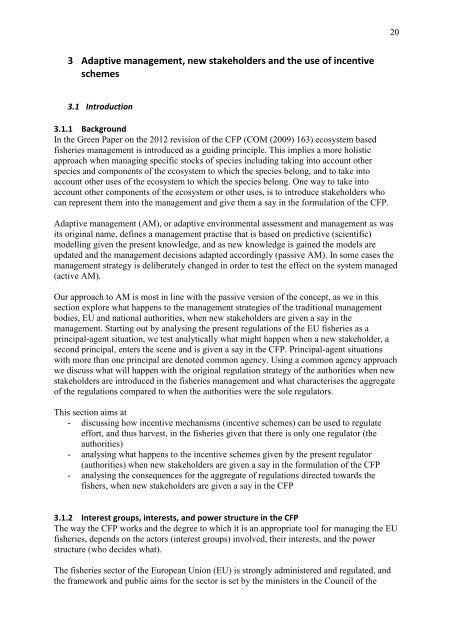Operational tools and adaptive management
Operational tools and adaptive management
Operational tools and adaptive management
Create successful ePaper yourself
Turn your PDF publications into a flip-book with our unique Google optimized e-Paper software.
3 Adaptive <strong>management</strong>, new stakeholders <strong>and</strong> the use of incentive<br />
schemes<br />
3.1 Introduction<br />
3.1.1 Background<br />
In the Green Paper on the 2012 revision of the CFP (COM (2009) 163) ecosystem based<br />
fisheries <strong>management</strong> is introduced as a guiding principle. This implies a more holistic<br />
approach when managing specific stocks of species including taking into account other<br />
species <strong>and</strong> components of the ecosystem to which the species belong, <strong>and</strong> to take into<br />
account other uses of the ecosystem to which the species belong. One way to take into<br />
account other components of the ecosystem or other uses, is to introduce stakeholders who<br />
can represent them into the <strong>management</strong> <strong>and</strong> give them a say in the formulation of the CFP.<br />
Adaptive <strong>management</strong> (AM), or <strong>adaptive</strong> environmental assessment <strong>and</strong> <strong>management</strong> as was<br />
its original name, defines a <strong>management</strong> practise that is based on predictive (scientific)<br />
modelling given the present knowledge, <strong>and</strong> as new knowledge is gained the models are<br />
updated <strong>and</strong> the <strong>management</strong> decisions adapted accordingly (passive AM). In some cases the<br />
<strong>management</strong> strategy is deliberately changed in order to test the effect on the system managed<br />
(active AM).<br />
Our approach to AM is most in line with the passive version of the concept, as we in this<br />
section explore what happens to the <strong>management</strong> strategies of the traditional <strong>management</strong><br />
bodies, EU <strong>and</strong> national authorities, when new stakeholders are given a say in the<br />
<strong>management</strong>. Starting out by analysing the present regulations of the EU fisheries as a<br />
principal-agent situation, we test analytically what might happen when a new stakeholder, a<br />
second principal, enters the scene <strong>and</strong> is given a say in the CFP. Principal-agent situations<br />
with more than one principal are denoted common agency. Using a common agency approach<br />
we discuss what will happen with the original regulation strategy of the authorities when new<br />
stakeholders are introduced in the fisheries <strong>management</strong> <strong>and</strong> what characterises the aggregate<br />
of the regulations compared to when the authorities were the sole regulators.<br />
This section aims at<br />
- discussing how incentive mechanisms (incentive schemes) can be used to regulate<br />
effort, <strong>and</strong> thus harvest, in the fisheries given that there is only one regulator (the<br />
authorities)<br />
- analysing what happens to the incentive schemes given by the present regulator<br />
(authorities) when new stakeholders are given a say in the formulation of the CFP<br />
- analysing the consequences for the aggregate of regulations directed towards the<br />
fishers, when new stakeholders are given a say in the CFP<br />
3.1.2 Interest groups, interests, <strong>and</strong> power structure in the CFP<br />
The way the CFP works <strong>and</strong> the degree to which it is an appropriate tool for managing the EU<br />
fisheries, depends on the actors (interest groups) involved, their interests, <strong>and</strong> the power<br />
structure (who decides what).<br />
The fisheries sector of the European Union (EU) is strongly administered <strong>and</strong> regulated, <strong>and</strong><br />
the framework <strong>and</strong> public aims for the sector is set by the ministers in the Council of the<br />
20

















